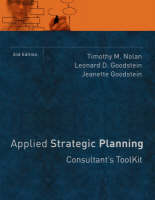
Applied Strategic Planning
Pfeiffer (Verlag)
978-0-7879-8851-7 (ISBN)
- Titel ist leider vergriffen;
keine Neuauflage - Artikel merken
Applied Strategic Planning: The Consultant's Toolkit is a powerful aid to consultants, facilitators and change agents engaged in implementing strategic planning with organizational- and executive-planning teams. This revised edition of the best-selling toolkit incorporates the most recent theory and research into strategic planning, as well as advances in the ASP model since the first edition was published. The kit includes all the materials required to guide the planning team toward an effective strategic plan, and follows the proven, nine-step ASP model.
Timothy M. Nolan, Ph.D. is President of Innovative Outcomes, Inc. as well as Executive Director of The Academy for Consulting Excellence, Inc., The Center for Leadership Excellence, Inc. and the National Centers for Learning Excellence, Inc. in Milwaukee, Wisconsin. He is author or co-author of 34 books. Leonard D. Goodstein, Ph.D., is a consulting psychologist located in Washington, D.C. He is the former CEO and Executive Vice President of the American Psychological Association, the world's largest membership association of psychologists. Since retiring from the APA, he has been an active consultant, researcher, and author, with over 20 published books. Jeanette Goodstein, Ph.D., also of Washington, D.C., has worked primarily in the non-profit sector both in the United States and abroad. The National Institute for Mental Health on human resource development issues has been among her consulting clients and, on behalf of its National Human Resource Development Task Force on Strategic Planning, she wrote the National Mental Health HRD Strategic Plan. She also chaired the Board of International Voluntary Services, a private non-profit organization dedicated to volunteer service in developing nations.
Preface. CHAPTER 1 INTRODUCTION TO APPLIED STRATEGIC PLANNING.
The Applied Strategic Planning Model.
Consultant to Consultant.
Notes on the Activities.
CHAPTER 2 THE ROLE OF THE CONSULTANT.
Outcomes of Strategic Planning.
How Applied Strategic Planning Is Different.
Major Roles of Consultants.
Knowledge and Skills.
Consultant to Consultant.
Notes on the Activities.
Activity 2.1: Clouded Vision: The Perils of Prediction.
Activity 2.2: One Thing: Identifying the Foremost Strategic Goal.
Activity 2.3: Identifying Important Strategic Issues.
Activity 2.4: Examining Your Consulting Style.
Activity 2.5: Testing Knowledge of the Strategic Planning Process.
CHAPTER 3 THINKING SKILLS.
A Variety of Thinking Skills.
The Importance of Creativity.
Down-Board Thinking.
Critical Thinking.
Synthesis as an Asset in Thinking.
Focused Thinking.
Framing and Reframing.
Visionary Thinking.
Scanning and Interpreting.
Fluidity of Thinking.
Intuitive Thinking.
Complexity in Thinking.
Strategic Thinking.
Systems Thinking.
Broad-View Thinking.
Analytical Thinking.
Meta-Cognition.
Scenario Thinking, Innovation, and Strategy Creation.
Final Thoughts on Thinking.
Consultant to Consultant.
Notes on the Activities.
Activity 3.1: Introducing and Using Paradigms.
Activity 3.2: Thinking Strategically.
Activity 3.3: Matching Thinking Skills to Steps of the Applied Strategic Planning Process.
CHAPTER 4 PLANNING TO PLAN.
Preliminary Contacts.
Readiness for Successful Strategic Planning.
First Steps.
Launching the Strategic Planning Process.
Establishing Norms for Work Group Behavior.
Additional Issues.
Implementation Is What It Is All About!
Consultant to Consultant.
Notes on the Activities.
Activity 4.1: Determining Organizational Readiness for Strategic Planning.
Activity 4.2: Assessing Organizational Commitment to Strategic Planning.
Activity 4.3: Choosing the Strategic Planning Work Group.
Activity 4.4: Identifying Stakeholders.
Activity 4.5: Bringing Closure to Planning to Plan.
CHAPTER 5 VALUES AND CULTURE.
Defi ntions.
Identifying and Clarifying Values.
Organizational Culture.
Consultant to Consultant.
Notes on the Activities.
Activity 5.1: Examining Organizational Values.
Activity 5.2: Measuring Organizational Values: An Empirical Approach.
Activity 5.3: Examining the Three Tensions: Learning About How You Manage Dilemmas.
Activity 5.4: Organizational Culture Questionnaire.
Activity 5.5: Bringing Closure to Values and Culture.
CHAPTER 6 MISSION FORMULATION.
Envisioning the Future.
Formulating the Mission Statement.
Crafting the Mission Statement.
Purposes of a Mission Statement.
Content of a Mission Statement.
Attributes of a Mission Statement.
Comprehensive Mission Statements.
Consultant to Consultant.
Notes on the Activities.
Activity 6.1: Creativity Session to Describe the Ideal Future.
Activity 6.2: “Hear All About It”: Envisioning the Future.
Activity 6.3: What? Who? How? Why? The Key Components of Mission.
Activity 6.4: Distinctive Competence.
Activity 6.5: Evaluating Mission Statements.
Activity 6.6: Bringing Closure to Mission Formulation.
CHAPTER 7 STRATEGIC BUSINESS MODELING.
First Steps.
Outcomes Generated by Strategic Business Modeling.
Consultant to Consultant.
Notes on the Activities.
Activity 7.1: Analyzing a Planning Case.
Activity 7.2: Identifying LOBs for the Future.
Activity 7.3: Identifying Required CSIs.
Activity 7.4: Analyzing Strategic Thrusts Needed.
Activity 7.5: Describing the Necessary Culture.
Activity 7.6: Bringing Closure to Strategic Business Modeling.
CHAPTER 8 PERFORMANCE AUDIT.
The Scope of Performance Audit.
A Useful Mind-Set.
The Role of the CEO in Performance Audit.
SWOT Analysis.
SWOT Analysis Looking Inward.
SWOT Analysis Looking Outward.
Consultant to Consultant.
Notes on the Activities.
Activity 8.1: Planning Data Collection for SWOT Analysis.
Activity 8.2: Analyzing Lines of Business.
Activity 8.3: Analyzing CSIs.
Activity 8.4: Organizational Systems Survey.
Activity 8.5: Analyzing LOB Life Cycles.
Activity 8.6: Analyzing Competition.
Activity 8.7: Analyzing Risk Orientation.
Activity 8.8: Bringing Closure to Performance Audit.
CHAPTER 9 GAP ANALYSIS AND CLOSURE.
The Outcomes Defi ne the Process.
Shaping Gap Analysis and Closure.
The Importance of Role Clarity.
Is the “Bench” Deep Enough?
Tactics for Closing the Gap.
Gaps That Cannot, or Should Not, Be Closed.
“Notes for Next Year”.
Consultant to Consultant.
Notes on the Activities.
Activity 9.1: Planning Gap Analysis and Closure.
Activity 9.2: Selecting Future Lines of Business.
Activity 9.3: Selecting the Future CSIs.
Activity 9.4: Identifying the Necessary Strategic Thrusts.
Activity 9.5: Identifying the Necessary Future Culture.
Activity 9.6: Bringing Closure to Gap Analysis and Closure.
CHAPTER 10 INTEGRATING ACTION PLANS.
Grand Strategies.
Developing Business Unit/Program Operational Plans.
Integrating Functional Action Plans.
Resource Allocation.
Consultant to Consultant.
Notes on the Activities.
Activity 10.1: Identifying the Primary Global Strategies.
Activity 10.2: Creating Action Plans.
Activity 10.3: Coordinating and Integrating Action Plans.
Activity 10.4: Bringing Closure to Integrating Action Plans.
CHAPTER 11 CONTINGENCY PLANNING.
The Need for Contingency Planning.
A Frequently Overlooked Contingency.
Criteria for Developing Contingency Plans.
Developing Contingency Plans.
Consultant to Consultant.
Notes on the Activities.
Activity 11.1: Learning to Use the Probability-Impact Planning Matrix.
Activity 11.2: Developing Contingency Plans for the Entire Organization.
Activity 11.3: Developing Contingency Plans for Each LOB.
Activity 11.4: Bringing Closure to Contingency Planning.
CHAPTER 12 IMPLEMENTING YOUR PLAN.
Presenting the Plan.
Strategic Management.
Blockages to Implementation.
Some Concluding Remarks.
Consultant to Consultant.
Notes on the Activities.
Activity 12.1: Evaluating Readiness to Implement the Strategic Plan.
Activity 12.2: Unveiling the Strategic Plan.
Activity 12.3: Ensuring Implementation.
Activity 12.4: Bringing Closure to Implementing Your Plan.
References.
About the Authors.
| Erscheint lt. Verlag | 18.7.2008 |
|---|---|
| Sprache | englisch |
| Maße | 292 x 300 mm |
| Gewicht | 2930 g |
| Themenwelt | Wirtschaft ► Betriebswirtschaft / Management ► Unternehmensführung / Management |
| ISBN-10 | 0-7879-8851-0 / 0787988510 |
| ISBN-13 | 978-0-7879-8851-7 / 9780787988517 |
| Zustand | Neuware |
| Haben Sie eine Frage zum Produkt? |
aus dem Bereich


